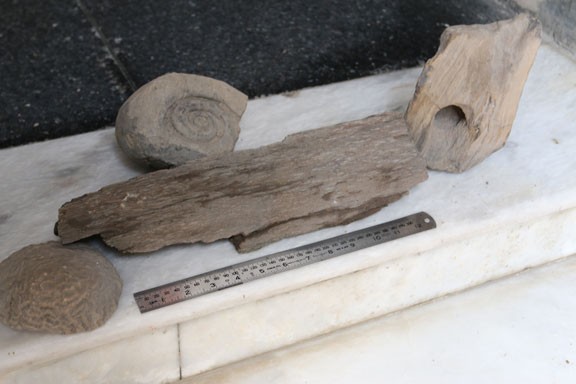

My collection of souvenirs is peculiar. No models of cars, trains or ships; or paintings or matchbooks from hotels around the world for me. I have a small collection of fossils picked up from the deserts and mountains of Sindh.
My first find was a pair of starfish fossils from just off Super Highway, about 70 km out of Karachi. The two were lying quite close to each other, undisturbed for a period of time that I could not comprehend at that time. Much later, I got a book on minerals, rocks and fossils and learned that every time I handled my fossils, I held in my hands a life form that lived in a very distant past: they, both Echinolampas, were from the Eocene period dating from 55.8 to 33.9 million years ago. These are no longer with me, having been gifted to my grand-niece and nephew in Canada.
But these earliest finds set off a fascination that has not died in nearly 40 years. I have since always walked with eyes down. Especially when I was walking in the Kirthar Mountains of Sindh or around their peripheries. Soon my collection grew. I found bi-valves: tiny cockles and palm-sized scallops that my book told me were from the Cretaceous period or about 100 million years old.
Then there was the large brain coral and an even larger ammonite. All these remains of marine creatures discovered more than a hundred kilometres inland reminded me of a time when that part of Sindh was under the sea.
On a trip to the historical fort of Rannikot in what was then Dadu district, I spotted a desiccated slope thinly littered with large pieces of timber. On closer examination I found that these were all fossilised. Hundreds of pieces of ancient trees completely turned to stone.
These were trees that had once stood tall and erect. They had taken root a few millions years after the prehistoric seas had receded and the land reclaimed by vegetation. This ancient landscape turned into forest where strange insects and mammals roamed feeding on the foliage of the trees whose trunks were now recumbent stone.
This turning into stone was no overnight event, however. Some ancient cataclysm had overturned the land, burying the forest deep where immense pressure over millions of years replaced the very structure of the timber, molecule by molecule, with whatever minerals the soil contained. A geologist later told me that colour of the fossil was taken from the mineral that transformed it to stone.
The beauty of the process was that it did not destroy the appearance of the timber: there were pieces with the bark intact. And this boggles the mind because this was no man-made process under extreme control to prevent damage. It was a huge upheaval that buried the forest. Yet, it was as if a part of the tree had just sheared off without breaking even a shred of the bark. It was easy to take the pieces as ordinary wood; only the dark shade and inordinate weight was a giveaway.
Among this collection of mine is a unique piece. Pale-coloured, an irregular rectangle (17×13 cm), it has a hole running through it. That is where a knot fell out when the tree yet lived! I am convinced that this has to be the only such piece to be found anywhere.
These souvenirs are all over my home. No one knows their value so they cannot be stolen. Few friends, and only those who are erudite, know what I have and only they pause to admire them and handle these pieces that lived eons before the first humans walked the face of the earth.